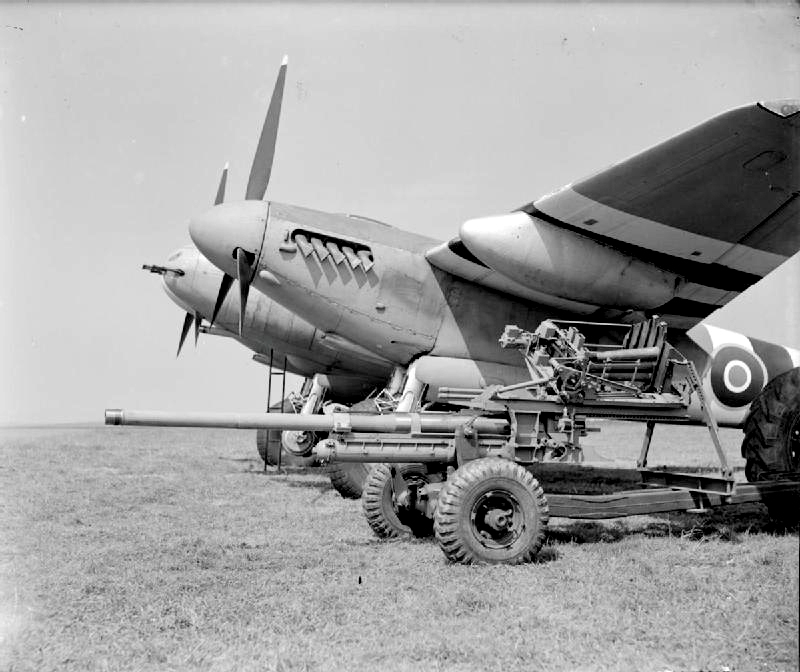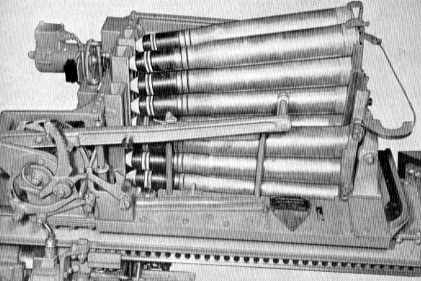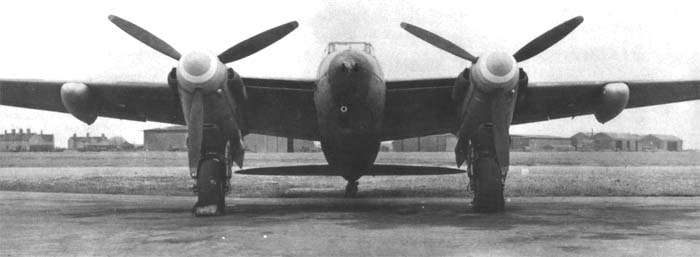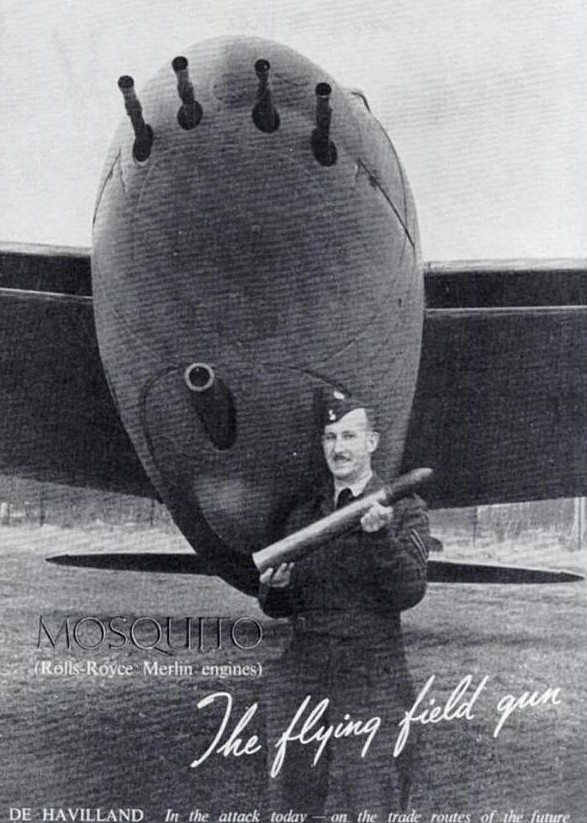Richard (Dick) Whittingham spent all his working life at de Havilland, starting as an apprentice in 1935 and finishing up as a senior production engineer. This is the seventh and final extract from Dick’s wartime diaries, adapted by his nephew Roger Coasby, and it gives a personal insight into those exciting days at Hatfield in the early 1940’s.
Big Gun Mosquito

“In May 1943 we were out on the airfield in front of the Experimental Dept: at Hatfield when we were surprised to see an Army lorry appear towing a 6 pounder field gun. It stopped in front of our flight hangar and unhitched the gun which was then quickly wheeled inside. We had no idea whatsoever why we needed a field gun, unless it was to provide DH’s Home Guard with some artillery – which seemed rather unlikely.
It shows how efficient wartime security was in the factory, because it was some time later when we found that the gun had been removed from its carriage and was being installed in a Mosquito in the Experimental Flight Hangar. We had been working on HJ732 for a few days without realising it was to become the prototype FB.XVIII with a 57mm gun fitted in the space normally occupied by the four 20mm cannons! There was a rumour that the gun feed mechanism had been made by a cigarette machine manufacturer, but it was not until after the war that we found out that this was true, and that the mechanism had been produced by Molins of Peterborough.
According to my wartime diary we spent the last week in May and the first week in June carrying out mods to the airframe, and getting it ready for flight, and on Saturday afternoon, June 5th, we towed it over to the gun butts which were situated on the northern edge of the airfield. There was a rough track leading to the butts and we positioned the aircraft on the track, and then raised it into a flying position by lifting the tail on to an adjustable trestle.

On the following day, a Sunday afternoon, we returned, and an electrician and I decided to check the gun’s firing mechanism one last time. While we were underneath with our heads in the gun bay I don’t know what the electrician did, but the gun’s loading mechanism suddenly came to life. Something which I can only describe as a large drum stick – a steel bar with a padded knob on the end – shot forward and attempted to load his fist into the breech of the gun! Judging by the yell he gave, it must have been extremely painful.
Having satisfied ourselves that the loading mechanism was working we then waited to see who was going to fire the gun. Before very long an RAF officer, accompanied by an Army officer, arrived and climbed into the plane. They then asked if it was lined up with the gun butts. There was no gun-sight fitted at this stage so someone had the bright idea of peering down the barrel. We all took turns in looking through the barrel and jacked the tail trestle up until we all agreed that we could see the heap of sand that was in the butts. We then gave the officers the thumbs up, and just had time to get into a ditch that was alongside the track when they fired the gun. We were absolutely appalled at the noise it made, and certainly didn’t expect it to be so loud.

One of the officers then got out and said “would someone start the engines, as we want to fire the next round with the engines running.” He was told that I would do that, but as I walked over to the plane I noticed that the blast from the muzzle had dented the underside of the nose. I then wondered what effect the blast would have on the propeller blades when they were rotating. Nevertheless I got into the cockpit with the two officers and removed the escape hatch in the roof to give myself a means of exit. I then started the engines, and when they were running at a fast idle speed, locked the throttles and said “I’m going to leave you to it now.” I then got out of the hatch and was almost blown towards the tail where I was caught by the lads as I dropped to the ground. We crouched down in the ditch again and the gun was fired for a second time.
We were pleased to see that there was no further damage to the nose and the plane was towed back to the hangar. It flew for the first time on the following Tuesday, June 8th 1943 and was delivered to Boscombe Down for acceptance trials on Saturday June 12th.
It became known as the “Tsetse” Mosquito. We called it the “Big Gun Mossie”, but a wartime DH pamphlet dubbed it the “Flying Field Gun” which is perhaps the best description of what was a remarkable achievement.”

To read more about the FB Mk. XVIII “Tsetse” Mosquito click here.
Roger Coasby is a member of the de Havilland Aeronautical Technical School Association. You can find out more about the DHAeTSA, which has over 500 members, on our Affiliates page here.
Have you visited the TPM shop yet? Our profits from sales go directly towards returning a Mosquito to Britain’s skies.
If you wish to donate directly towards our fund, please visit our Donate page.

Hi, There’s a broken picture /link above.
http://www.peoplesmosquito.org.uk/wp/wp-content/uploads/2012/01/raf_mosquito_with_molins_gun_wwii_iwm_ch_14114.jpg
Thanks for highlighting Ricky!
Pingback: The Wartime Diaries of Dick Whittingham – a de Havilland Engineer | The People's Mosquito
Reblogged this on Aviation Trails and commented:
A really interesting account from a behind the scenes engineer. Always good to hear about the first hand experience of those connected with aircraft development.
Hi. Thanks for reblogging. It is a fascinating record of an interesting moment in time – have you read the other instalments of the diary (pts 1-6)? I will be publishing a postscript on Dick Whittingham when I get a chance. Thanks again. Nick
Hi Nick, it was my pleasure always glad to assist in promoting the project and also the lives of the ‘ordinary’ people behind the story. I have read some of the instalments, the intention is to read them all as time allows. Diaries and personal accounts certainly are interesting to read and a terrific insight into times past. Looking forward to further publications. Best wishes Andy.